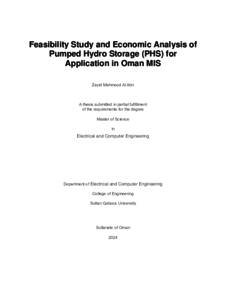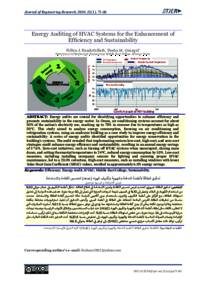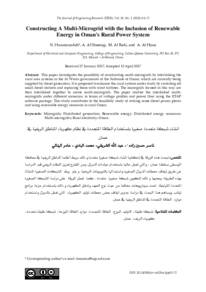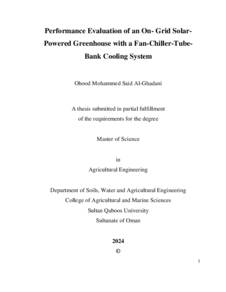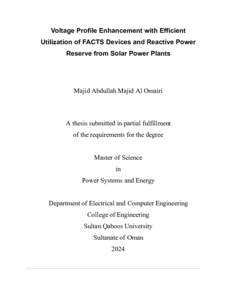وثيقة
Feasibility study and economic analysis of pumped hydro storage (PHS) for application in Oman MIS.
المصدر
Master's thesis
عناوين أخرى
دراسة الجدوى والتحليل الاقتصادي لأنظمة تخزين الطاقة باستخدام نظام الضخ والتخزين المائي للتطبيق في الشبكة الكهربائية الرئيسية في سلطنة ُعمان
الدولة
Oman
مكان النشر
Muscat
الناشر
Sultan Qaboos University
ميلادي
2024
اللغة
الأنجليزية
نوع الرسالة الجامعية
Master's thesis
الملخص الإنجليزي
The subject matter is consistent with the goals of Oman Vision 2040, which seeks to diminish
reliance on non-renewable resources and promote the use of clean resources such as renewable
energy to lower production costs and consequently boost the competitiveness of economic sectors.
Energy Storage System (ESS) solutions will play a dominate role in achieving this aim. Storing
energy is very beneficial specially with the availability of the renewable energies like solar energy.
The solar energy during the day can be stored during the low demand and utilized during the high
demand. Moreover, in spot markets, the excess energy in the grid will not be wasted. As it is
expected that the renewable energy sector in the world will achieve rapid growth and the current
trend towards implementing economic reforms so the regional energy storage system market will
be booming. Energy storage will help to reduce the cost of the electricity compared with the
conventional energy system within the upcoming years and will make some stability improvement
for the electrical network systems as well.
This thesis has focused on the technical and economic feasibility of the application of Pumped
Hydro Storage (PHS) in Oman’s main interconnected system (MIS). The study has been carried
out to achieve suitable selection of the PHS and location. The sizing and the preliminary design of
PHS has been determined. Finally, a simplified economic study has been carried out for the
proposed design.
The detailed examination of Oman's MIS revealed the emergence of a pronounced duck curve
effect, resulting from the mismatch between peak renewable generation during midday and peak
electricity demand in the early evening. This effect, along with the intermittent nature of solar
energy, highlighted the need for energy storage solutions to maintain grid stability and optimize
the utilization of renewable resources.
Through a comprehensive site identification and evaluation process, the study identified several
potential locations for PHS development in Oman, with Wadi Dhyqa 1 (A1) emerging as the most
suitable site based on the multi-criteria decision-making analysis. The preliminary design of the
PHS system, considering factors such as configuration, turbine selection, and storage system
components, further demonstrated the technical feasibility of implementing PHS in Oman.
The techno-economic analysis, which compared the levelized cost of energy (LCOE) of PHS with
that of open-cycle gas turbine (OCGT) and combined cycle gas turbine (CCGT) power plants,
revealed that PHS is a more cost-effective option, particularly when the OCGT and CCGT plants
operate at lower capacity factors or when fuel prices are high. This finding underscores the
economic viability of PHS as a long-term solution for managing the variability of renewable
energy sources in Oman's MIS.
الملخص العربي
يتماشى موضوع البحث مع أهداف رؤية ُعمان ،2040 التي تسعى إلى تقليل الاعتماد على الموارد غير المتجددة وتعزيز استخدام الموارد الطبيعية مثل الطاقة المتجددة لخفض تكاليف الانتاج وبالتالي تعزيز تنافسية القطاعات الاقتصادية. ستلعب حلول نظام تخزين الطاقة دو ًرا مهًما في تحقيق هذا الهدف. إن تخزين الطاقة يعد مفيدًا بشكل خاص مع توافر أنواع الطاقات المتجددة مثل الطاقة الشمسية، حيث يمكن تخزين الطاقة الشمسية خلال النهار في أوقات الطلب المنخفض أو أوقات التوليد الكهربائي العالي من الطاقة المتجددة واستخدامها خلال أوقات الطلب المرتفع. عالوة على ذلك، الفائض من الطاقة في الشبكة لن يُهدر في الاسواق . ونظ ًرا للتوقعات بأن قطاع الطاقة المتجددة في العالم سيشهد نمًو الفورية ا سريعًا والاتجاه الحالي نحو تنفيذ الاصالحات الاقتصادية، فمن المتوقع أن يشهد سوق نظام تخزين الطاقة الاقليمي ازدها ًرا. سيساعد تخزين الطاقة على خفض تكلفة الكهرباء مقارنة بنظام الطاقة التقليدي المعتمد على الوقود الاحفوري في السنوات القادمة وسيسهم في تحسين الاستقرار ألنظمة الشبكات الكهربائية. ركزت هذه الرسالة على الجدوى الفنية والاقتصادية لتطبيق تخزين الطاقة بالضخ المائي في الشبكة الكهربائية الرئيسية في سلطنة ُعمان. تم إجراء الدراسة لتحقيق اختيار السعة المناسبة لتخزين الطاقة بالضخ وموقعه. تم تحديد السعة الالزمة للتخزين وعمل التصميم المبدئي لنظام تخزين الطاقة بالضخ. وأخيرا، تم إجراء دراسة اقتصادية مبسطة للمقترح. كشف تحليل الطاقة للشبكة الرئيسية عن تأثير منحنى البطة الناتج عن عدم التطابق بين ذروة توليد الطاقة المتجددة خلال منتصف النهار وذروة الطلب على الكهرباء في بداية المساء. وقد أبرز هذا التأثير، إلى جانب الطبيعة غير المستقرة لتوليد الكهرباء من الطاقة الشمسية بسبب تأثرها بحالات الطقس، الحاجة إلى حلول لتخزين الطاقة للحفاظ على استقرار الشبكة وتحسين استخدام الموارد المتجددة. من خلال عملية تحديد وتقييم المواقع الشاملة، حددت الدراسة عدة مواقع محتملة لتطوير تخزين الطاقة بالضخ في ُعمان، حيث برز سد وادي ضيقة كأنسب موقع استنادًا إلى تحليل اتخاذ القرار متعدد المعايير. وقد أظهر التصميم المبدئي لنظام تخزين الطاقة بالضخ المائي، مع الاخذ بعين الاعتبار عوامل مثل التركيب الاساسي واختيار التوربينات ومكونات نظام التخزين، الجدوى الفنية لتنفيذ تخزين الطاقة بالضخ المائي في ُعمان. أظهر التحليل الفني الاقتصادي، الذي قارن تكلفة الطاقة ال ُمعدَّلة لتخزين الطاقة بالضخ مع تلك الخاصة بمحطات توربينات الغاز ذي الدورة المفتوحة ومحطات توربينات الغاز ذي الدورة المركبة أن تخزين الطاقة بالضخ هو الخيار الاكثر فعالية من حيث التكلفة، خاصة عندما تعمل محطات الاحتراق بالوقود أو البخار بعوامل قدرة أقل أو عندما تكون أسعار الوقود مرتفعة. ويؤكد هذا على الجدوى الاقتصادية لتخزين الطاقة بالضخ كحل طويل الامد إلدارة تقلبات مصادر الطاقة المتجددة في الشبكة الكهربائية الرئيسية في السلطنة.
قالب العنصر
الرسائل والأطروحات الجامعية

